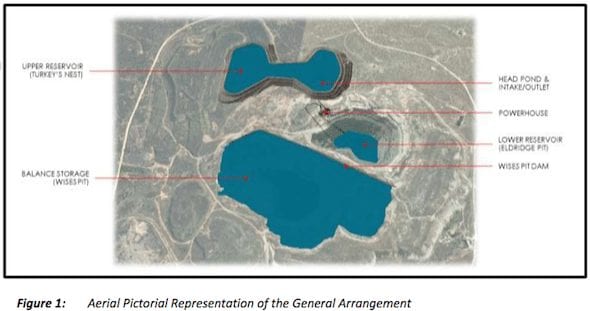Plans to turn a disused North Queensland gold mine into Australia’s biggest renewables-based energy storage project are one step closer to being realised, after the successful completion of a feasibility study into the project.
ASX-listed company Genex Power said on Tuesday that the study had found the Kidston pumped hydro project – which will be unique in the world – to be technically feasible, with the favoured design capable of delivering 250MW of generation capacity, with six hours of continuous generation, and 1,500MWh of total storage capacity.

As we reported last month, the study’s findings are expected to pave the way for Genex to seek funding for the ambitious project, which will also include some 180kms of transmission. Genex said in a statement it would “immediately commence” financing activities, in the hope of bringing the project online as soon as possible, with an anticipated target of Q4 2017 to reach financial close.
The project, which has been provided with $4 million in funding from the Australian Renewable Agency (ARENA), and in September secured 20 year power purchase agreement from the Queensland government, will essentially convert the mine into a giant battery by exploiting the sheer vertical drop of an old open pit gold mine.
As well as storing the power from a potentially 200MW – but initially 50MW – solar array, the idea is to pump water into an upper storage reservoir through the day or overnight when energy prices are low, and then release it into a lower reservoir to generate power during periods of high demand or need, offering the same kind of grid support services as a gas or coal-fired power plant.
And as ARENA CEO Ivor Frischknecht has pointed out, “it comes at a time when cost effective storage options are becoming increasingly important as more large-scale renewable energy generation enters the national electricity market.”

Frischknecht said Queensland was fast adopting renewables and was set to add 300MW of new large-scale solar next year, with support from ARENA’s latest competitive funding round.
“This includes a 50 megawatt solar farm being developed by Genex at the Kidston site, with potential to use solar to power the storage plant’s water pumps,” he said.
The company said the project was now fully designed, including the civil works program and detailed mechanical equipment specifications, and it was working with power and water consultants Entura to develop capital cost estimates.
“Genex is now focused on securing finance for the project and is fast-tracking revenue and contracting negotiations,” Frischknecht said.
“If everything goes to plan, Genex should reach financial close and start construction in 2017, in an achievement that would pave the way for more large pumped hydro storage projects at disused mines to support our energy grids.”
As we have noted here before, Genex director Simon Kidston is the great great grandson of the former Queensland premier after whom the mine was named. But he says the family never had any equity in the mine and his involvement is just a coincidence.
Kidston is a former investment banker who had investments in the metallurgical coal industry. When he sold that interest to Chinese parties in 2013, he stood back and saw the changes in the energy market.
“We recognised that changes were happening in the energy industry. They were building LNG plants (for the export market) and we saw that the gas price was going to go up, and we did some research and saw that if renewables were to take off, their intermittency would cause increased volatility in the markets,” he said.








